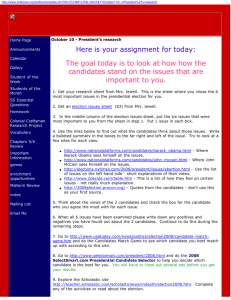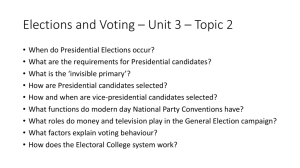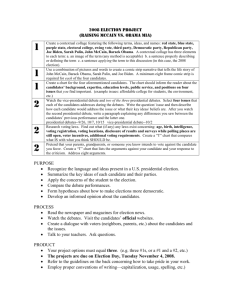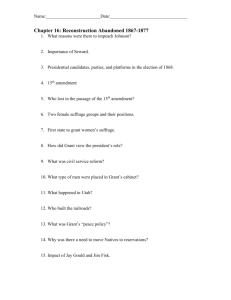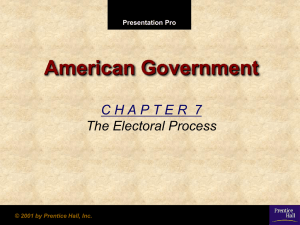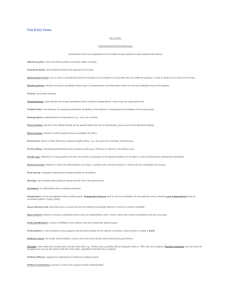Chapter 5
advertisement
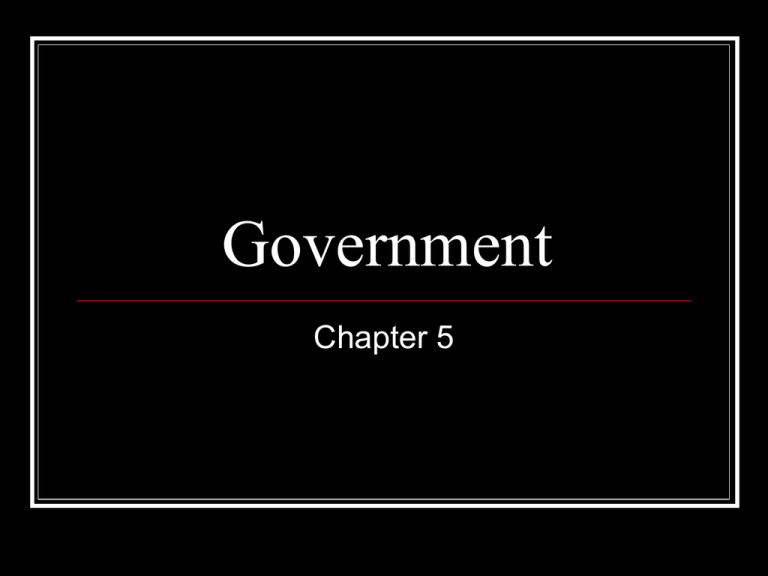
Government Chapter 5 Chapter 5 Section 1 Political Parties A political party can be defined in two ways: 1. A group of persons who seek to control government through the winning of elections and the holding of public office. 2. A group of persons joined together on the basis of certain common principles, who seek to control the government in order to bring about the adoption of certain public policies and programs. -First definition fits the Dems and Repubs because they are election oriented not policy oriented. -Democrats and Republicans can be thought of as a coalition: a union of many persons of diverse interest who have come together to get their candidates elected to public office. Political Parties What do parties do? Serve as a link between the people and their government. Help unify the American people by making compromises on different issues. Doesn’t always happen. Political parties have five other main functions. Functions of Political Parties Nominating Function: nominate or name candidates for public office. Informer-Stimulator Function: informs the people and stimulates their interests and participation in public affairs. Campaigns for the candidate, educates the public through buttons, signs, and ads. Seal of Approval Function: in choosing their candidates, the party tries to see that they are men and women who are both qualified and of good character. Make sure that candidates do good in office so as to make the party look good. Functions of Political Parties Government Function Government by party. Political appointees done by party. Voting in Congress done along party lines. Watchdog Function Party not in power keeps an eye on the party in power and makes voters aware of any wrong doing. Chapter 5 Section 4 Minor Parties 1. Four distinct types of minor parties: Ideological party: based on a particular set of beliefs, a comprehensive view of social, economic, and political matters. -Most are Marxist and based on the ideas of Karl Marx -Do not get many votes, but are long lasting. -Examples: Socialist and Communist Parties. Minor Parties 2. Single-issue parties: concentrate on a single public policy matter. -Name of party usually tells about the party. -Usually fade into history as their issue fades. -Example: Free Soil Party-opposed the spread of slavery. Minor Parties 3. Economic Protest Parties: rooted in period of economic discontent, no clear cut ideological base. -Disappear when economic troubles are over. 4. Splinter parties: parties that split away from one of the major parties. -Usually form around some strong personality who have most likely failed to win the main party nomination. -Most often ends when its leader steps down. -Example: Bull Moose Party, Dixiecrats. Key Role of Minor Parties 1st to use the national convention to pick their candidates. Strong 3rd party candidate can play a spoiler role in elections. Most important role is as a critic and innovator. Takes a stand on critical issues and brings issues to the public’s attention. Major party adopts the issues of the minor party as their own therefore frustrating the minor party and making them obsolete. Chapter 5 Section 5 Organization of Political Parties Reality of political parties is that they are not as cohesive as you might think. They are very decentralized and fragmented. There is not really a chain of command running from the national to the state level. The President of the U.S. has the role of trying to be a party leader and super politician. Structure of the National Party Machinery National Convention Meets in the summer of every presidential election year to nominate a presidential candidate. Party platform is written here. National Committee Contains many of the party’s leading figures. Committee does not have much clout and main job is the plan the next convention. Structure of the National Party Machinery National Chairperson Selected by the presidential candidate and confirmed by the committee. Is the leader of the national committee and serves a four-year term. Directs the work of the party’s HQ in D.C. In election year, concentrates on the convention and then the campaign. In off years, tries to promote party unity, raise money, recruit new voters, and prepare for the next election. Congressional Campaign Committee Tries to get incumbents reelected and save retiring seats. Tries to unseat other party’s incumbents. State and Local Party Organization State Organization Independent from national organization. Led by a State central committee and State chairperson. Work together to build party unity, raise funds, and find candidates. Local Organization Each district has a party. Most of the time they are inactive until right before the election Pig-Pie-Po The three basic elements of the party: 1. Party in Government (Pig): party members who hold elected or appointed offices at the national, state and local levels. 2. Party in the Electorate (Pie): citizens who support, identify with the party and its candidates. 3. Party Organization (Po): party committees, officers, and workers. *Future of major parties (in book)



